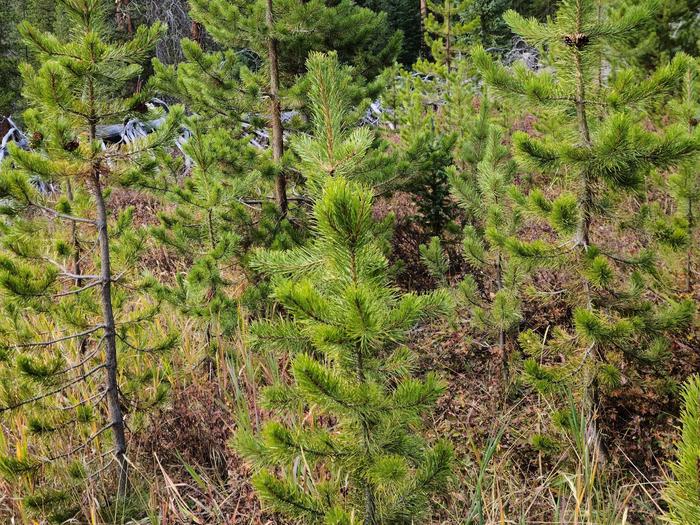Black Hills National Forest Christmas Tree Permit
This permit allows you to cut a Christmas Tree within designated areas of the Black Hills National Forest. Lifelong memories with family and friends are built during these special times, and the Forest is happy to help with any information gathering you will need to make this experience safe and enjoyable.
The Forest encompasses over 1.2 million acres (2,000 square miles) of varied landscapes, habitats, cultural sites, and recreational opportunities. It is a wonderland in all four seasons, and the winter months make for some enchanting moments while searching for the "perfect" tree. We hope you take some time to explore and discover the beauty of the Black Hills and appreciate its natural and cultural diversity.
Did you know ... your tree is just one of the many products national forests provide. Through careful management, the Black Hills National Forest also offers outdoor recreation, wildlife habitat, clean water, livestock grazing, timber products, and minerals.
Please be sure to read and agree to all the tips and guidelines when selecting your tree. Visit the Black Hills National Forest online for additional information related to camping, hiking, and other recreational activities.
Need to Know
Selecting Your Tree
Each forest has limitations on the size of the tree you can cut and the species of trees that are permitted. See below to help you measure and choose a tree that meets your permit's guidelines.
Tree height: 20 feet maximum
Stump height: 6 inches maximum
Stump diameter: 6 inches maximum
Take the whole tree. Do not remove the top of the tree; cut down the entire tree
If snow is on the ground, remove it from around the stump so you can accurately measure the stump and tree height.
Where to Cut Your Tree
Cut trees only within the boundaries of the Black Hills National Forest and respect surrounding private property.
Trees may not be cut in developed recreation sites, such as campgrounds, picnic sites, and day-use areas. Furthermore, trees cannot be cut from Forest Service administrative sites, within active timber sales, Black Hills Experimental Forest near Rochford, Black Elk Wilderness Area, Beaver Park near Sturgis, or within Spearfish Canyon.
Planning Your Trip
Helpful Cutting Tips
We encourage you to select a tree from a dense forested area, which will give the remaining trees more space to grow.
Once your tree is safely down, please cut the leftover branches from the stump and scatter them over the ground in the local area.
Carry your tree carefully out of the forest. Dragging the tree often rubs off needles and may remove some bark.
If the tree is too big to transport inside your vehicle, wrap it in canvas to prevent wind damage while driving home.
Once home, cut the bottom of the trunk off and place the freshly cut trunk in a bucket of water. Replenish the water as needed, and always ensure that dead clumps of needles are actively removed from the tree while inside your home.
If you are storing your tree outside before taking it into your home, keep it in an area protected from wind, such as the north or east side of your house, under a raised deck, or inside a garage or shed.
How to Plan Your Trip
Before you leave home, measure the space where you plan to place the tree (height and width) and also measure the available space in your vehicle where you will be transporting the tree.
You must print and bring your Christmas Tree Permit with you. Please be advised that screen shots and/or pictures of online permits do not qualify and are not accepted as "proof of purchase."
For your safety, we encourage everyone to share their plans and locations with family and friends. If an emergency situation occurs, cell service may be spotty or unavailable. Be proactive with your communication and trip planning.
We also encourage everyone to check the latest weather conditions, forest warnings, and road closures before you leave on your trip. Weather conditions in the Black Hills may change abruptly, along with new project locations taking place on the Forest. It is your responsibility to be aware of the various situations that might affect your experience.
Bring a map with you. Do NOT rely on GPS, as some systems may not be up-to-date with forest service roads.
Dress warm and take extra dry clothes. Expect winter weather, including cold temperatures, snow, and wind.
Roads may not be plowed. Depending on your planned travel, carry tire chains, shovel(s), and a tow chain. Be sure your vehicle has a full tank of gas. Bring a spare key for your vehicle, and give it to someone else in your party for added security. Park in areas that allow others to drive by safely, and perhaps most important, do not block gates or other access roads.
Bring plenty of food and water with you, as well as an overnight survival kit in case you become stranded. Be sure to find your tree and leave the woods before dark.
We do not recommend bringing your pets. However, if you do bring a pet, we encourage you to keep it secured in your vehicle.
